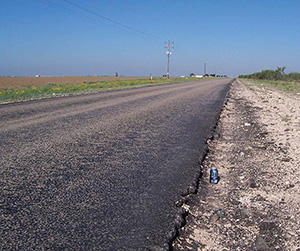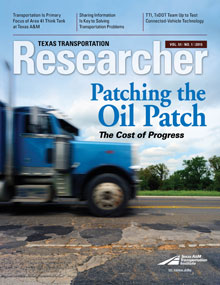The energy sector is having a dramatic positive economic impact on Texas and the nation. But many Texas roadways have experienced accelerated pavement degradation due to heavy truck loads and increased traffic. An interagency agreement between the Texas Department of Transportation (TxDOT) and the Texas A&M Transportation Institute (TTI) seeks to give districts the necessary tools to combat this problem.

The rapid development of the state’s oil and gas resources requires large volumes of relatively heavily loaded trucks per well. Approximately 900 oil/gas drilling rigs (about half of all rigs in the United States) operate in Texas. Estimates of truck traffic for well development and early production range from 1,000 to 4,000 loaded trucks per well.
“One of the major issues facing TxDOT maintenance forces is repairing the road network damaged by the extra traffic servicing wells,” says TTI Executive Associate Director and Senior Research Fellow Jon Epps. “The maintenance and repair of the Texas roadway system have required an ever-increasing amount of TxDOT’s financial resources and available workforce.”
The TxDOT Maintenance Division/Pavement Asset Management group and an interdisciplinary research team at TTI are working together to provide support to the districts in affected areas and to supply decision-making information. The project objectives are to:

- determine and analyze experiences by personnel in the field;
- facilitate communication across district lines to share information; and
- develop documentation and guidelines to capture best practices.
“What we’re trying to achieve with this effort is to get the latest research and information related to energy-sector roadway repair strategies to the districts most impacted,” says TxDOT Transportation Engineer Mark McDaniel. “This is an evolving field, and we want to use our district visits and workshops to define district practices associated with oil/gas development and production.”
The group has presented two workshops, one in San Antonio and one in Odessa. The group has also prepared a series of energy-sector technical briefs documenting the findings of pavement analyses used to determine recommended shoulder widths and corresponding roadway widths, and shoulder/edge repair techniques. The briefs are quick-read documents providing useful information for the districts.
“Even though there has been a recent slowdown in the energy-development sector, it is still critical that the districts work to repair their roadways,” says Epps. “Hopefully these workshops and supporting documents will help to ensure that the correct and most current state-of-the-practice guidelines are being used.”



 Estimates of truck traffic for well development and early production range from 1,000 to 4,000 loaded trucks per well.
Estimates of truck traffic for well development and early production range from 1,000 to 4,000 loaded trucks per well.